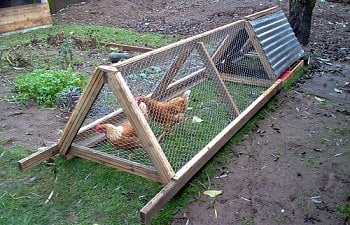Tractor vs. Permanent Coop - the Pros and Cons
Briana Farrell
One of the first questions you will (hopefully) ask yourself before you bring your chickens home is: Where should I put them and what will I put them in? There are certainly many different styles of housing for chickens. The two most common options are the Tractor Coop and the Permanent Coop. Both have many advocates, and both have their advantages and disadvantages.Briana Farrell
Tractor coops are great for small numbers of chickens and large spaces. They are basically big movable rectangular frames with chicken wire over the sides, and are usually floor-less. Often constructed of wood, PVC pipe, or metal framework, they usually have a coop with closed-in sides at one end with nesting boxes and roosts where the hens lay their eggs and sleep, so they can be left there all day and night. They have daily access to fresh grass and peck around and eat bugs and fertilize and scratch the manure into the ground while they’re at it. The grass loves it, and ours is growing like crazy even in the middle of winter. The chickens are never in the same spot for more than twenty-four hours, therefore avoiding nasties like coccidiosis and parasites. You never have to replace the bedding or clean out the coop, and it never smells bad. Many chicken keepers opt for the tractor coop for the many benefits it provides.
The major downside with the tractor coop is the need to move it daily, which can be especially unpleasant in inclement weather. Since it is portable, the coop must be light and easy to move (and therefore small), so it has room only for a few chickens. And unless you have a big enough space to move it around to a fresh spot every day, your yard will soon be scratched to bits and all the grass will be gone. Since the coop is always open to the outdoors, hanging a light in the coop during winter to help with laying will not work. Also, since tractor coops need to be lightweight and portable, they tend not to be as strong as permanent coops, and therefore easier for predators to break into. Animals that can dig (such as foxes) could have easy access to the chickens and eggs, owing to the fact that chicken tractors are usually floor-less.
Permanent coops are essentially a basic house/shed-like structure, usually with a fenced-in run. They are easy and simple to set up. You build or buy a chicken coop, put a fence around it or attach a run, and there you go. You will never have to move it, and if you use the deep-litter system, you will have a steady supply of fabulous compost for your garden. Since it does not have to be portable, the coop can be more solid to keep out predators and temperature extremes, with sturdy walls and floors. You can hook up an outlet to provide electricity for lighting and a water supply for running water. Permanent coops don’t require much space. They are very secure and are better suited to cold climates than tractor coops. For many, permanent coops are the favored option because of their security from the elements and predators.
The biggest disadvantage to housing your birds in a permanent coop is the maintenance issue. At a minimum of a few times per year, you will have to clean out all the old bedding and chicken manure. If you use the deep-litter system, the coop will need to be cleaned less often, but still at least once annually. Another major disadvantage is that the chickens will always be in the same place, so any ground that they have access to will soon become bare dirt. Parasites such as scaly-leg mites can be a problem. And the smell can be an issue with your neighbors. The chickens will have to be closed up every night to protect them from nocturnal predators, a chore that can be a nuisance in bad weather. The coop itself can be expensive to build, because it will require more lumber (or whatever other material you plan to use) than a tractor coop. If you want to buy an already-built permanent coop, they tend to be much more pricey than smaller, lighter chicken tractors.
There is a dazzling array of available chicken housing out there, ranging from building plans for both kinds of coops to pre-built structures that are readily available in feed stores and on the internet. Permanent coops and tractor coops come in all varieties, sizes and designs. Based on your own personal criteria, environment, and available space, either kind of housing may be just right for you. I hope I have shed some light on the advantages and disadvantages of the different types of chicken housing, and helped you decide which is best for you and your chickens!

